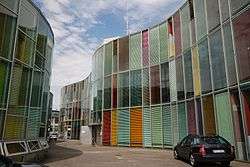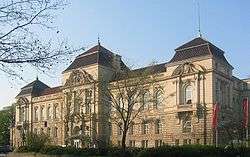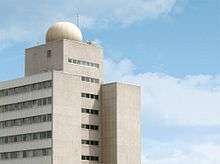Universities and research institutions in Berlin

The Berlin-Brandenburg capital region is one of the most prolific centers of higher education and research in the world.[1] It is the largest concentration of universities and colleges in Germany. The city has four public research universities and 27 private, professional and technical colleges (Hochschulen), offering a wide range of disciplines.[2] Access to the German university system is tuition free.
175,000 students were enrolled in the winter term of 2014/15.[3] Around 20% have an international background. Student figures have grown by 50% in the last 15 years. The Humboldt Universität zu Berlin (HU Berlin) has 34,000 students, the Freie Universität Berlin (Free University of Berlin, FU Berlin) has 34,000 students, and the Technische Universität Berlin (TU Berlin) around 30,000 students. The Universität der Künste (UdK) has about 4,000 students and the Berlin School of Economics and Law has enrollment of about 10,000 students.
40 Nobel Prize winners are affiliated to the Berlin-based universities.
History
The Prussian Academy of Arts (German: Preußische Akademie der Künste) was an art school set up in Berlin, Brandenburg, in 1694/1696 by prince-elector Frederick III, in personal union Duke Frederick I of Prussia, and later king in Prussia. It had a decisive influence on art and its development in the German-speaking world throughout its existence. It dropped 'Prussian' from its name in 1945 and was finally disbanded in 1955 after the 1954 foundation of two separate academies of art for East Berlin and West Berlin in 1954. Those two separate academies merged in 1993 to form Berlin's present-day Academy of Arts.
The Humboldt University of Berlin is one of Berlin's oldest universities, founded in 1810[4] as the University of Berlin (Universität zu Berlin) by the liberal Prussian educational reformer and linguist Wilhelm von Humboldt, whose university model has strongly influenced other European and Western universities.
Universities
Public universities
There are five big internationally renowned research universities in the Berlin-Brandenburg capital region:
- Freie Universität Berlin (FU Berlin), a German University of Excellence
- Humboldt University of Berlin (HU Berlin), a German University of Excellence
- The Charité is a medical school, one of the largest university hospitals in Europe
- Technical University of Berlin (TU Berlin) has large international student enrollment
- Berlin University of the Arts (UdK) is the largest art school in Europe
- University of Potsdam is situated in the south western part of the metropolitan region
Private Universities
There are five recognized private universities in Berlin:
- ESCP Europe Wirtschaftshochschule Berlin
- Hertie School of Governance
- Steinbeis-Hochschule Berlin
- ESMT European School of Management and Technology
- Touro College Berlin
Colleges of Applied Sciences
Berlin has several private, professional and technical colleges (Hochschulen)
- Alice Salomon Hochschule Berlin
- Berlin School of Economics and Law
- Berufsakademie Berlin
- Beuth Hochschule für Technik Berlin
- German Academy for Film and Television Berlin ("dffb Deutsche Film-und Fernsehakademie Berlin")
- European College of Liberal Arts (An English-language higher-educational institution).
- Evangelische Fachhochschule
- Hochschule für Technik und Wirtschaft Berlin
- Fachhochschule für Verwaltung und Rechtspflege Berlin
- Hochschule für Musik Hanns Eisler
- Hochschule für Schauspielkunst „Ernst Busch“
- International Business School
- Katholische Fachhochschule
- Katholische Hochschule für Sozialwesen Berlin
- Kunsthochschule Berlin-Weißensee (Hochschule für Gestaltung)
- Mediadesign Hochschule
- OTA private University of applied sciences Berlin (OTA Hochschule Berlin)
- Teikyo University, Berlin campus
- Touro College Berlin
- BAU International Berlin University of Applied Sciences
Research institutions
Berlin has a high density of research institutions, such as the Fraunhofer Society, Gottfried Wilhelm Leibniz Scientific Community and the Max Planck Society, which are independent of, or only loosely connected to its universities. A total number of 62,000 scientists are working in research and development. The city is one of the centers of knowledge and innovation communities (Future Information and Communication Society and Climate Change Mitigation and Adaptation) of the European Institute of Innovation and Technology (EIT).[5]

- Berlin-Brandenburgische Akademie der Wissenschaften
- Biologische Bundesanstalt für Land- und Forstwirtschaft
- Bundesanstalt für Materialforschung und -prüfung (BAM)
- Bundesinstitut für Risikobewertung
- Deutsche Telekom Laboratories (affiliated with TU Berlin)
- German Archaeological Institute (DAI)
- Deutsches Bibliotheksinstitut
- Deutsches Herzzentrum Berlin
- German Institute for Economic Research (DIW Berlin)
- Deutsches Institut für Urbanistik
- Ecologic gGmbH
- Fachinformationszentrum Chemie
- Ferdinand-Braun-Institut für Höchstfrequenztechnik
- Forschungsinstitut für Molekulare Pharmakologie
- Helmholtz-Zentrum Berlin (BESSY)
- Institut für Museumskunde
- Institut für Ökologische Wirtschaftsforschung gGmbH
- Institut für Planetenforschung of the Deutsches Zentrum für Luft- und Raumfahrt
- Institute for Media and Communication Policy
- Institut für Zoo- und Wildtierforschung
- Institute for Cultural Inquiry
- Institute of Electronic Business
- Zuse Institute Berlin (ZIB)
- Leibniz-Institut für Gewässerökologie und Binnenfischerei
- Leibniz-Institut für Kristallzüchtung
- Leibniz Sozietät
- Max-Born-Institut für Nichtlineare Optik und Kurzzeitspektroskopie
- Max Delbrück Center for Molecular Medicine
- Otto Suhr Institute for Political Science (OSI) of the Freie Universität Berlin
- Paul-Drude-Institut für Festkörperelektronik
- Physikalisch-Technische Bundesanstalt (PTB)
- Robert Koch Institute (RKI)
- Socio-Economic Panel (SOEP)
- Telekom Innovation Laboratories
- Umweltbundesamt
- Weierstraß-Institut für Angewandte Analysis und Stochastik
- Wissenschaftskolleg zu Berlin - Institute for Advanced Study, Berlin
- Wissenschaftszentrum Berlin für Sozialforschung
- Wissenschafts- und Wirtschaftsstandort Adlershof
Max-Planck Institutes
- Fritz Haber Institute of the MPG (FHI)
- Max-Planck-Institut für Bildungsforschung
- Max-Planck-Institut für Infektionsbiologie
- Max Planck Institute for Molecular Genetics (MOLGEN)
- Max Planck Institute for the History of Science
Fraunhofer Institutes
- Fraunhofer-Institut für Nachrichtentechnik
- Fraunhofer-Institut für Offene Kommunikationssysteme
- Fraunhofer-Institut für Produktionsanlagen und Konstruktionstechnik
- Fraunhofer-Institut für Rechnerarchitektur und Softwaretechnik
- Fraunhofer-Institut für Software- und Systemtechnik
- Fraunhofer-Institut für Zuverlässigkeit und Mikrointegration
Nobel Prize winners
There are 40 Nobel laureates affiliated to the Berlin-based Universities:
|
|
See also
References
- ↑ "Best universities in Germany 2017". THE. Retrieved 22 September 2016.
- ↑ "Metropolis of Sciences". Berlin Partner GmbH. Archived from the original on 24 April 2008. Retrieved 19 August 2008.
- ↑ "HochschulenBerlin mit neuem Studentenrekord". Focus (in German). 25 November 2015. Retrieved 1 December 2015.
- ↑ "International Higher Education : Countries and rEgions". Ejournals.bc.edu. Retrieved 2016-08-28.
- ↑ "European Institute of Innovation and Technology: Home". Europa (web portal). Retrieved 8 June 2010.





.png)
